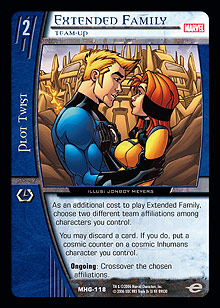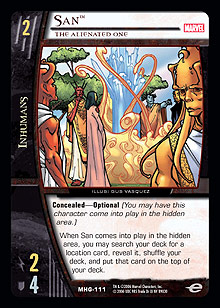There are quite a few ways to go if you’re building a rogue deck. The most common is to maximize one aspect of your game. If you’re playing aggro, kill as quickly as possible; every single card you play should be chosen for maximum damage potential. If you’re stall, whether you’re based on brickwalling attacks or exhausting characters, your deck should be focused on that single goal. If you’re a combo deck, your best chance to win is to combo out as quickly as you possibly can.
There is another route, though—the type of deck that’s actually called a “metagame deck.” This style of deck isn’t as common in Vs. System as it is in other games (because most high-level tournaments in Vs. start with an unknown metagame), but it does occasionally rear its ugly head. It isn’t chosen for power, and it’s rarely a good choice in an unknown metagame. Rather, a good metagame deck finds the vulnerabilities in popular decks and exploits them. It isn’t powerful generally, but it has an answer for the situations that will most commonly come up throughout the day and uses those answers to win the game with a less powerful deck.
Chris Darmadi and Alex Antonios are young Australian players with (get this) a penchant for deckbuilding. $10K Sydney was Chris's most successful outing yet—he earned a Top 8 finish. Chris eventually lost in the quarterfinals to Michael Lou and the Skrull deck. Alex had Top 8’d at $10K Melborne with essentially the same deck a few months before. Below is Chris’s version; Alex played a Destroyer, Harbinger of Devastation instead of a Gorilla Grodd, and another Attilan in place of a second Null Time Zone.
Characters
4 Lockjaw, Inhuman’s Best Friend
3 Frankie Raye ◊ Nova, Optimistic Youth
 2 Mikado and Mosha
2 Mikado and Mosha
4 San
4 Tonaja
1 Dr. Doom, Richards’s Rival
3 Terrax, The Tamer
1 Thing, Rockhead
1 Morg, Corrupt Destroyer
1 Gorilla Grodd
1 Terrax, Harbinger of Ruin
Plot Twists
2 Null Time Zone
3 Meltdown
4 Flying Kick
4 No Man Escapes the Manhunters
4 Extended Family
4 Enemy of My Enemy
Locations
4 The Great Refuge
3 Attilan
2 Worldship
1 Slaughter Swamp
The first thing you might ask yourself about this deck is, “What the heck is going on?” I’m pretty sure that was my first impression. There are some unusual cards and numbers in here, but after taking the deck for a spin and asking Chris about the build, it made much more sense. Chris’s explanation: “I chose the deck because it could beat most of the decks in the metagame and was just unexpected in a metagame full of Kree and Lost in Space. It was also good against Good Guys and Squadron matchups.” Given that information, the choice makes much more sense. Chris played against Kree and Lost in Space in eight out of ten rounds and went into the Top 8 with an 8-2 record. Coincidence?
I know some of you are thinking that this deck doesn’t matter. Lost in Space is dead. With the Dr. Light, Master of Holograms and Frankie Raye ◊ Nova, Optimistic Youth bannings, the deck can’t possibly survive. But that’s not really the point. The point is to see how rogue deckbuilders can pick apart the weaknesses they find in popular decks.
For instance, this deck’s designers looked at the metagame and saw two decks: Kree and Lost in Space. For each deck, they figured out the most important aspect and a way to neutralize it. A Kree deck essentially goes off on turn 6. It doesn’t do much while it’s preparing its press turn, and when that turn comes, the deck can easily do 60 or more points of damage. So, what was the solution for that deck? Don’t let it get to turn 6! To beat Kree, this deck goes all-out with Tonaja on turn 3, Morg on turn 4, and Karnak on turn 5. If Kree makes it to turn 6, though, you still have some game. Attilan gives you easy access to Null Time Zone. You’ll want to Null naming Lunatic Legion on turn 6 before your opponent plays any characters (that is, while it still costs 8) so that he or she can’t play it in response. If you have a second Null Time Zone, name Live Kree or Die! The opponent will be forced to try to get to you without either card, and you still have an entire army in the hidden area waiting to hit him or her back. If you played Terrax, The Tamer on turn 4, then you can play Gorilla Grodd and steal an opposing character. And if you played Morg, you can force your opponent to stun a character with Terrax, Harbinger of Ruin. You might have to race on turn 6, but you should win that race.
Lost in Space is a much more difficult deck to battle, but the designers found a way: Karnak. Lost in Space focuses on using Lex Luthor, Criminal Genius to keep the opponent from attacking on turns 4 and 5. If the opponent does attack, he or she has to send so much damage into Lex Luthor that almost no progress will be made against the Lost in Space player’s life total. Then Lost in Space takes control of the game on the later turns. But when Karnak’s involved, nothing works the way it should. If Lex is 20 ATK / 20 DEF, then Karnak is a 20-point ATK pump, negating any advantage that the Lost in Space player gained by inflating him. When you take away Lex Luthor’s huge size advantage, Lost in Space folds like a house of cards.
 By finding a chink in the armor of the two most powerful decks, this deck could win its way into the Top 8 on the backs of those two matchups. You still need to draw the right cards, though, which is where San, Attilan, and your own Frankie Rayes come in. San gets you the Attilan you need to find all the cards you want. Frankie Raye allows you to draw the cards you put on top of your deck. You can also use Terrax, the Tamer to put the card on top of your deck into your resource row, where you can get at it. If you happen to have Dr. Doom, Richards’s Rival in play, then you can KO one of your characters to slide your Attilan into the row. With these tricks, you can draw whatever cards you need to draw on turns 4, 5, and 6 against whatever deck you happen to be playing against.
By finding a chink in the armor of the two most powerful decks, this deck could win its way into the Top 8 on the backs of those two matchups. You still need to draw the right cards, though, which is where San, Attilan, and your own Frankie Rayes come in. San gets you the Attilan you need to find all the cards you want. Frankie Raye allows you to draw the cards you put on top of your deck. You can also use Terrax, the Tamer to put the card on top of your deck into your resource row, where you can get at it. If you happen to have Dr. Doom, Richards’s Rival in play, then you can KO one of your characters to slide your Attilan into the row. With these tricks, you can draw whatever cards you need to draw on turns 4, 5, and 6 against whatever deck you happen to be playing against.
The deck didn’t just have game against the top two contenders. In almost all tournaments, if you beat the best two decks but can’t beat anything else, you won’t be making money. Even in the most lopsided metagames, the two most popular decks won’t make up more than about sixty percent of the metagame. If you don’t have the ability to beat anything else, beating the top two decks will get you nowhere unless you sacrifice your soul to the gods of parings.
Predictably, though, this deck included a few little surprises against some of the other popular decks, as well. Three Meltdowns is more than enough to pry an Amulet of Nabu off a pesky Quicksilver, Inhuman by Marriage; Katar Hol ◊ Hawkman, Thanagarian Enforcer; or the occasional Squadron Supreme character. Null Time Zone can go a long way toward stopping the more unusual decks that always float around at $10K events. Scarecrow, Fearmonger is easily searchable, a big visible body if it’s needed, and quite good against the Skrull aggro decks because it can remove cosmic counters from Wolverine, Skrunucklehead; Captain America, Skrull Impostor; Ethan Edwards; and especially Paibok. No Man Escapes the Manhunters does double duty as an ATK pump and a way to disrupt the Skrull deck.
This deck couldn’t be a better example of how to attack a metagame. The most popular decks were clear: Kree and Lost in Space. Darmadi and Antonios attacked those two decks with targeted power and consistency while making considerations for other decks, as well. Their deck wasn’t a generically powerful deck, but it had the answers it needed to compete in the metagame for which it was designed.
Also, now that Lost in Space is gone, this deck isn’t just going to roll over and die. The beauty of this particular deck is that it’s a strong frame from which to combat many decks. Fast hidden beats plus a way to play answers to the metagame consistently is a winning strategy as long as you have the right answers. If you’re paying attention to the metagame, then you can always have the cards you need within easy reach. With Lost in Space gone, Karnak may seem less important, but there is no character in Vs. System that’s better against curve decks. The combat pump he provides is bigger than anything else you will find, he’s on team, and he’s reusable. He needs to stay in the deck. Gorilla Grodd is especially good against off-curve strategies since your most common 4-drop will be Terrax. You can switch up the plot twists to suit the local metagame, and if you find you need a different character to answer your particular problem, it’s only an Enemy of My Enemy away.
The key to a focused rogue deck is consistency in theme. The key to a metagame deck is answers and ways to find them. This deck has the answers to Kree, Lost in Space, and most of the rest of the field. It has a way to find those answers in Enemy of My Enemy; Dr. Doom, Richards’s Rival; and particularly Attilan. Answers plus a way to find them will lead you to the Promised Land—a Top 8 with your favorite deck.